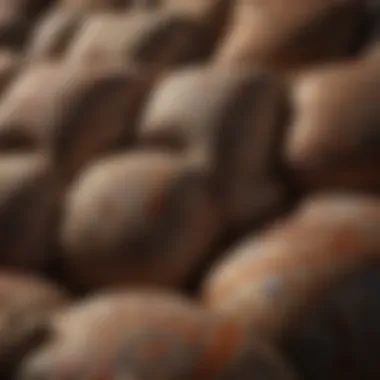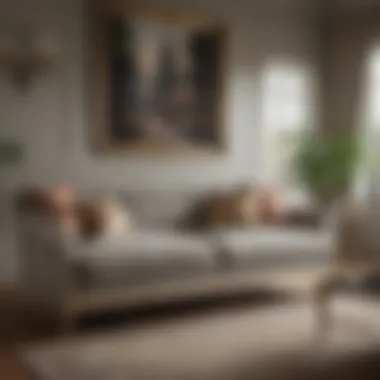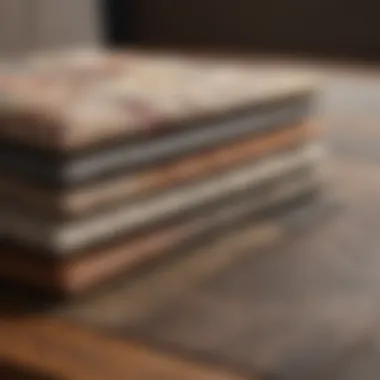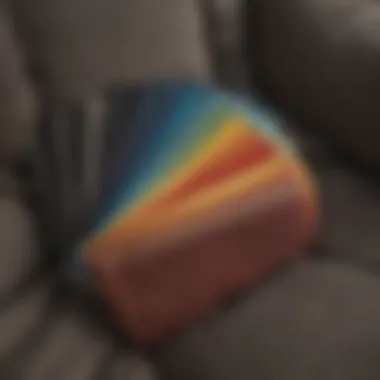Top Fabrics for Couch Reupholstery: A Guide


Intro
Reupholstering a couch can refresh your living space. Whether you want to maintain the charm of an antique piece or modernize a tired sofa, the choice of fabric significantly impacts both aesthetics and functionality. Selecting the right material takes careful thought. Durability, style, texture, and maintenance ease must all align with your lifestyle and design vision. This guide will help you identify the best fabric options, equipping homeowners and design enthusiasts with essential knowledge for their upholstery projects.
Design Inspiration
Current Interior Design Trends
Understanding current design trends can guide fabric selection. Popular styles today include minimalism, vintage, and eclectic designs. For minimalists, clean lines and neutral tones in fabrics like linen or cotton are attractive. Vintage lovers might lean towards rich damask or tapestry, which adds texture and a sense of history. The eclectic approach often combines various styles, suggesting bold patterns and colors.
Selecting the right fabric means considering how it fits within these trends while catering to personal taste. For example, a pastel velvet fabric could serve modern and vintage styles alike.
Color Palettes and Their Effects
Colors can evoke specific feelings; thus, color choice in upholstery is vital. Neutral colors create a serene environment, making them suitable for living rooms meant for relaxation. Rich, deep hues, like navy or emerald, can add drama and sophistication. Bright colors, such as yellows and oranges, may invigorate a space and inspire energy.
When selecting fabric colors, consider the overall color palette of the room, including walls and accessories. Here are some popular choices and their effects:
- Warm colors (reds, oranges, yellows): Create excitement and warmth.
- Cool colors (blues, greens, purples): Promote calmness and tranquility.
- Neutrals (beiges, whites, grays): Offer balance and versatility.
"Choosing the right color can elevate the overall atmosphere of your home, making it feel both inviting and reflective of your personality."
Considering current trends and color effects can significantly influence your choice of fabric, ensuring it meets both functional and aesthetic objectives. By doing so, you make an informed choice, leading to a more satisfying upholstery project.
Prologue to Reupholstering
Reupholstering is a critical process in maintaining or enhancing the aesthetics and functionality of your furniture. This article delves into the significance of selecting the right fabric when reupholstering a couch. The correct material influences durability, visual appeal, and ease of maintenance. For homeowners or design enthusiasts, understanding these aspects is essential to ensure that their investment remains valuable over time.
Purpose of Reupholstering
Reupholstering serves several purposes. Primarily, it restores the couch's condition, making it look new again. This process can be more economical compared to purchasing new furniture, particularly for valuable pieces. Additionally, reupholstering provides an opportunity to customize the style of the couch. Homeowners can select fabrics that match their decor or express personal taste. Furthermore, reupholstering allows one to upgrade to more functional textiles, useful for pets or children.
Understanding Fabric Choice
Fabric choice is vital in the reupholstering process. Different materials come with distinct properties that affect how the couch performs over time. Durability is a significant factor; some fabrics can withstand wear and tear better than others. For example, synthetic fibers might offer increased resilience compared to natural options. Equally important is maintenance. Certain fabrics require more care and attention than others. Additionally, the texture and overall look of the fabric must align with the intended style of the living space. Interior designers often emphasize the importance of this aspect. It is essential to understand both the practical and aesthetic implications of fabric selection to achieve the desired results.
Key Considerations Before Choosing Fabric
When considering reupholstering a couch, selecting the right fabric is crucial. The fabric can dictate the longevity, comfort, and overall aesthetic of the furniture piece. Each choice carries weight; therefore, understanding specific considerations adds value to the decision-making process. An informed selection maximizes satisfaction and functionality while enhancing the space's overall appeal.
Durability and Wear Resistance
Durability is one of the most significant factors when choosing upholstery fabric. It is vital, especially for furniture that will undergo regular use. Fabrics vary widely in terms of wear resistance. For instance, synthetic fibers often outperform natural fibers in this aspect. Look for fabrics that have a high double rub count. Notably, a higher count indicates a greater ability to withstand wear and tear.
Leather is a strong option due to its resilience. It can handle daily usage without losing its charm. Polyester blends also provide a good balance of durability and comfort. If the couch will be in a high-traffic area or used frequently, prioritizing durable fabrics can save money in the long run by reducing the need for repairs or replacements.
Ease of Maintenance
Another fundamental consideration is the ease of maintenance associated with the chosen fabric. Cleaning methods and the frequency of upkeep vary significantly from one material to another. For instance, cotton may require more rigorous cleaning schedules compared to microfiber. This can impact your decision, especially for families with young kids or pets.


Microfiber, in contrast, offers a straightforward cleaning process. It resists stains remarkably well, making it a practical choice. On the other hand, natural fabrics like linen often need dry cleaning, which can introduce inconvenience. Therefore, always check the care instructions before finalizing your choice.
Aesthetic Compatibility
Aesthetic compatibility is equally essential. The fabric should harmonize with the overall design scheme and style of a room. Consider factors like color, texture, and patterns. Neutral tones can easily blend in with various decor styles, while bold colors and intricate patterns can become statement pieces.
For example, if the couch is to be the focal point, choosing a vibrant fabric can enhance the room's character. On the contrary, if you prefer the couch to complement its surroundings, opting for more understated patterns may be advisable.
Environmental Impact
In today’s world, environmental considerations cannot be overlooked. The production processes, materials, and dyes involved in making fabric can affect the planet. Fabrics made from organic materials generally have a lower environmental impact. Additionally, synthetic fabrics often contribute to pollution during their manufacturing processes.
Consider fabrics certified by organizations such as the Global Organic Textile Standard (GOTS) or OEKO-TEX, which indicate sustainable production methods. Making an eco-conscious choice not only helps the environment but can also appeal to like-minded individuals looking for sustainable solutions in home decor.
"Choosing the right fabric is not just about aesthetics; it's about durability, maintenance, and your impact on the environment."
These key considerations serve as a guideline for selecting the appropriate fabric for your upholstery projects. Weighing each aspect carefully will lead to a well-informed decision, ensuring that the chosen fabric meets both functional and aesthetic needs.
Popular Fabric Options for Reupholstering
When considering reupholstering a couch, the choice of fabric plays a critical role in enhancing both functionality and aesthetics. Different fabrics offer distintive qualities that cater to various needs, such as durability, comfort, and style. This section explores popular fabric options widely used for upholstery and outlines their unique characteristics, benefits, and considerations.
Leather
Benefits and Limitations
Leather is often seen as a luxury choice for reupholstering. Its durability is one of its most significant benefits, often lasting many years without extensive wear. However, it can be prone to scratches and may require specific care to maintain its luster. It is a popular selection for high-traffic areas and has a timeless appeal. On the downside, the initial cost of leather can be relatively high when compared to other options. Overall, it remains a sought-after fabric due to its classic elegance and ability to fit into various design aesthetics.
Types of Leather
There are several types of leather, including full-grain, top-grain, and bonded leather. Each type offers distinct characteristics. Full-grain leather is the most durable and develops a beautiful patina over time, making it a premium choice. Top-grain leather, while also durable, undergoes a finishing process that may remove some natural imperfections. Bonded leather is a mix of genuine leather and synthetic materials, often more affordable but less luxurious. Choosing the right type of leather involves considering both budget and desired longevity.
Care and Maintenance
Caring for leather involves regular cleaning using a damp cloth to remove dirt and applying leather conditioner periodically to prevent drying. Avoid exposing leather to excessive sunlight or heat. While its maintenance is manageable, neglect can lead to cracking or fading. Proper care enhances the lifespan and appearance of leather upholstery, making it a wise choice for investment.
Cotton
Attributes of Cotton
Cotton is a naturally occurring fabric known for its softness and breathability. It is a versatile material that can suit various styles, from casual to formal. One primary advantage of cotton is its accessibility and affordability. However, cotton can be less durable than synthetics, making it more suitable for low-traffic areas. Its ability to take dye well allows for a wide array of colors and patterns, enhancing creative options for homeowners.
Best Use Cases
Cotton is ideal for furniture that is used less frequently, such as accent chairs or decorative couches. It is suitable for spaces where comfort is a priority, as it retains a softer feel. On the other hand, it might not be the best choice for households with pets or children, as it can stain easily. Understanding how and where the couch will be used is essential when considering cotton for upholstery.
Care Recommendations
To maintain cotton fabric, regular vacuuming can help remove loose dirt. Stains should be treated quickly with mild soap and water. Depending on the weave, cotton can be machine-washable for certain options. However, it is prudent to check labels for specific cleaning instructions. While cotton is manageable, its longevity can be lower if not cared for properly.
Linen


Characteristics of Linen
Linen is a light and breathable fabric made from the flax plant. Its natural sheen and texture give it a uniquely refined appearance. Although it has a reputation for being luxurious, linen is also more prone to wrinkling. Its strength is commendable, but it demands a certain level of care to maintain its look and feel through regular use.
Durability Considerations
While linen is strong, it can wear down with regular washing. Its resilience does not equate to being as durable as leather or polyester. Additionally, it is not resistant to stains, which means spills should be addressed immediately. When choosing linen for upholstery, understanding the balance between its elegance and care needs is important for making informed decisions.
Cleaning Guidelines
Cleaning linen involves dry cleaning, as regular washing can warp the fibers. Spot cleaning is usually recommended to prevent extensive wear. Sunlight is also not friendly to linen as it can cause fading. Thus, placing linen covers in shaded areas and following through on regular care can prevent premature damage.
Polyester
Advantages of Polyester
Polyester is a synthetic fabric with several advantages, including high durability and excellent resistance to fading, stretching, and shrinking. It is easy to clean and maintains its shape well, making it an excellent option for busy households. Given its affordability, polyester has gained popularity as a fabric of choice for upholstery projects that require both flexibility and longevity.
Common Blends
Many upholstery fabrics use polyester blends for enhanced characteristics. For instance, a cotton-polyester blend combines cotton's softness with polyester's durability. These blends often capitalize on the strengths of both fabrics, reducing weaknesses while providing an elegant finish. Understanding the blend ratios can assist in discerning the quality and suitability for specific upholstery needs.
Maintenance Tips
Maintaining polyester fabric is relatively straightforward. Regular vacuuming and spot cleaning with mild detergent can keep it looking fresh. For deeper cleaning, machine washing is often an option for removable covers, but always check care labels. Investing time in maintenance can enhance both appearance and lifespan, making it an advisable choice for many homeowners.
Microfiber
Description and Benefits
Microfiber is composed of extremely fine synthetic fibers, which give it a soft and suede-like feel. It is known for its stain resistance and easy cleanability. Microfiber is often chosen for its practicality, especially in homes with children or pets. Its affordability combined with its aesthetic appeal makes it a frequent choice among homeowners looking to balance budget and quality.
Suitability for Pets
Microfiber's tight weave makes it a favorable option for pet owners, as it resists pet hair and is less likely to snag. It also holds up against spills and stains, which are common in pet households. Its durability against claws and fur makes it a wise selection for maintaining an attractive living space without constant worry over wear.
Cleaning Methods
Cleaning microfiber requires specific techniques to ensure it lasts. Most stains can be removed using a mixture of rubbing alcohol and water applied with a soft cloth. Regular vacuuming is advised to eliminate dust and hair. Microfiber can trap dirt, so establishing a cleaning routine is important. Having the right tools and knowledge ensures that microfiber remains in great condition.
Fabric Texture and Patterns
Selecting the right fabric for reupholstering a couch extends beyond mere color choice. The texture and patterns play a pivotal role in determining the overall ambiance of a room. Understanding how these elements interact with light, wear, and space can deeply influence not just the appearance but also the functionality of the upholstery. This section will delve into the significance of texture and patterns, providing insights that will aid homeowners and design enthusiasts in making more informed decisions for their upholstery projects.
Understanding Texture
Texture refers to the surface quality of the fabric. It can be smooth or rough, glossy or matte. Each type of texture brings a different feel and look to the furniture. For instance, a velvet fabric offers a rich, luxurious texture, whereas linen is more casual and breathable. Texture affects both the tactile sensation and visual impact of the upholstery. Choosing a specific texture can enhance comfort, add depth, and create visual interest in spaces.
When selecting fabric, pay attention to how the texture interacts with your existing decor. A coarse texture can create contrast against smoother surfaces in the environment. Therefore, understanding the context in which the couch will be located can direct texture choices effectively.
Choosing Patterns


Patterns also play a vital role in fabric selection for upholstery. They can tell a story or impart a sense of style to a living space. Patterns often include florals, geometric designs, or abstract motifs. The choice of pattern should resonate with personal style and complement other design elements present in the room.
Impact on Space
Patterns can significantly alter the perception of space. For smaller rooms, lighter and smaller patterns may enhance the sense of openness. Conversely, larger patterns can create a focal point, drawing attention to key areas in a more expansive environment. When considering fabric patterns, balance is crucial. A well-placed pattern can inject life into a room, while an overwhelming design might create visual clutter.
One notable characteristic of patterns is their ability to hide wear and stains. Fabrics with intricate patterns often better camouflage marks compared to solid colors. This can be particularly advantageous in high-traffic areas or homes with children and pets. However, choosing a pattern requires careful consideration to ensure that it fits harmoniously within the overall decor.
Personal Style Considerations
Personal style plays an essential role in the choice of patterns. Comfort and familiarity with certain designs influence how a space feels. Subtle designs may evoke calmness, while bold patterns can energize a room. It is advisable to reflect on personal tastes and how they translate into fabric choices. Take the time to explore a range of options before making a decision.
Additionally, the unique feature of personal style considerations comes from the emotional response specific patterns can elicit. Classic prints may feel timeless and sophisticated, while contemporary patterns can resonate with modern aesthetics. By aligning fabric choices with individual preferences, the choice of upholstery can become a true reflection of one's style.
Ultimately, combining the right texture and patterns can elevate a reupholstering project. Being deliberate in these choices not only enhances the aesthetic but also supports practical advantages, like maintenance and comfort. Dedicating time to this process ensures satisfaction in the final results, making the upholstery fit seamlessly into the desired environment.
"Selecting the right texture and pattern can transform any couch into a centerpiece of your living space."
Evaluating Cost and Budget
Evaluating the cost and budget for reupholstering your couch is essential for a successful project. This section highlights not only the financial aspects but also how they intertwine with the overall quality of the materials. Proper budgeting can mean the difference between a project that meets expectations or one that falls short due to overlooked costs. Understanding what you are investing in, both in short-term and long-term benefits, allows you to make informed decisions.
Cost of Fabrics
The cost of fabrics is variable and it largely depends on the type chosen, the quality, and the source. For instance, natural fabrics like leather and linen may carry a higher price due to their durability and aesthetics. On the other hand, synthetic options like polyester can offer more budget-friendly choices without sacrificing too much in performance. Pricing can also fluctuate based on established trends.
Here are some general price ranges you might expect:
- Leather: $30 to $100 per yard depending on quality and type.
- Cotton: $10 to $30 per yard based on weave and design.
- Linen: $15 to $50 per yard depending on the blend and treatment.
- Polyester: $10 to $25 per yard typically.
- Microfiber: $15 to $40 per yard, depending on brand and quality.
When considering costs, be aware of factors like shipping or additional treatment for some fabrics. The price may also rise if the fabric is part of a limited collection or designer brand.
Balancing Quality and Budget
Finding balance between quality and budget is crucial. Spending too little can result in poor choices that wear out quickly, leading to more expenses in the future. Quality fabrics tend to last longer and withstand more wear and tear, making them a worthwhile investment.
Here are some tips for maintaining this balance:
- Assess Your Needs: Understand your lifestyle and how the couch will be used. If you have children or pets, investing more in durable fabrics might be wise.
- Consider Longevity: Higher-quality fabrics may seem expensive initially but could save money in long-term usage.
- Explore Sales and Discounts: Many suppliers often have sales that offer quality fabrics at reduced prices. Subscribing to newsletters or following them on social media can keep you informed on deals.
- Test Before You Buy: If possible, obtain swatches to assess how different fabrics feel, wear, and clean.
The End and Final Thoughts
Reupholstering a couch is a significant task, and selecting the right fabric is a crucial aspect of this process. This article has highlighted various fabrics available, with specific attention to their durability, aesthetic appeal, maintenance requirements, and environmental considerations. Understanding these aspects empowers homeowners and design enthusiasts to make informed choices aligned with their preferences and lifestyle.
Summary of Key Points
In summarizing the key points from this article, consider the following important elements:
- Durability is essential: Fabrics like leather or microfiber may offer greater durability options for busy households, particularly if pets or children are present.
- Maintenance matters: Ease of cleaning can affect the long-term enjoyment of your reupholstered couch. Fabrics like polyester are often easier to care for than natural linens.
- Aesthetic considerations: One should contemplate how the fabric’s color and texture match the existing decor. Patterns can influence the room's visual dynamics significantly.
- Environmental issues: The impact of fabric choices on the environment is becoming an increasing concern. Sustainable materials provide not just style, but also responsibility.
Encouragement for Thoughtful Selection
Thoughtful selection of upholstery fabric should not be rushed. Each fabric carries its unique benefits and limitations. Consider lifestyle, personal taste, and the functional needs of your space. Here are a few encouragements for making an informed choice:
- Evaluate your environment: Assess factors such as foot traffic, sunlight exposure, and potential stains when selecting a fabric.
- Research thoroughly: Learning about different fabrics can help steer clear of uninformed choices.
- Test samples: Whenever possible, obtain fabric swatches to examine color, texture, and durability before making a final decision.
Ultimately, the process of reupholstering can rejuvenate not just a couch, but the entire living environment. A well-chosen fabric can enhance comfort, style, and longevity.















